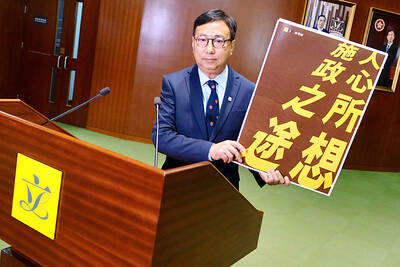China issued its first indictments on Friday in connection with July’s bloody rioting between minority Muslim Uighurs and majority Han Chinese, the country’s worst outbreak of ethnic violence in decades.
Twenty-one people — mostly Uighurs — face charges including murder and arson, Xinhua news agency reported. Most of those identified in the report were Uighurs, although two Han men were also named as murder suspects.
Nearly 200 people were killed and 1,700 injured in the ethnic violence in the city of Urumqi, capital of the far western region of Xinjiang. Most of the victims were believed to be Han, millions of whom have migrated to Xinjiang since the imposition of communist rule in 1949.
The prosecutions have the potential of calming fear and anger among Han, tens of thousands of whom marched in street protests earlier this month to demand swift punishment of the riot’s perpetrators and an end to a string of deeply unsettling needle attacks.
The protests, in which five people were killed, resulted in the firing of Urumqi’s Chinese Communist Party (CCP) secretary — the city’s top official — as well as Xinjiang’s police chief.
Xinhua said that in handing down the indictments, Urumqi’s prosecutor declared the facts in the cases clear and the evidence sufficient.
The crimes had “caused great losses to people’s lives and property, seriously damaged social order, and the guilty must be prosecuted to the full extent of the law,” Xinhua said, adding that more indictments were expected soon.
Hundreds of people were detained following the riots and officials said earlier that 83 people had been formally arrested.
The fate of the other detainees remains unclear.
Xinhua did not say what penalty those charged faced if convicted, although shortly after the riot, officials said the death penalty would be sought in serious cases.
A woman from the political department of the Urumqi Intermediate Court confirmed the Xinhua report, but would not give her name or any other details.
The violence in Urumqi underscored simmering resentment among many Uighurs over what they consider Chinese occupation of their land and heavy-handed CCP controls over religion and cultural activities. Uighur extremists have long waged a low-intensity insurgency against Chinese rule, although they are believed to be few in number and poorly organized.
China has accused exiled Uighur leader Rebiya Kadeer of fomenting the July violence, but has provided no direct evidence. Kadeer and other overseas Uighur activists have denied the claims and accused police of carrying out mass detentions.
The violence broke out on July 5 after police attacked Uighurs demanding a probe into the deaths of at least two Uighurs in a mass brawl at a factory in the country’s southeast that started after Han workers accused Uighurs of molesting a Han woman.
Uighurs then rampaged through Han neighborhoods in the overwhelmingly Han city, attacking passers-by, smashing and looting property, and burning cars and buses. Police were slow to respond and two days later, Han vigilantes armed with knives and clubs roamed city streets carrying out revenge attacks on Uighurs.
Massive numbers of paramilitary police have since been deployed to guard government buildings and Uighur areas and the city remains tense. The needle attacks that authorities have blamed on Islamic separatists then began in last month, further unnerving the Han population.
Police quickly arrested a number of suspects in the attacks and an Urumqi court has sentenced seven to prison terms of up to 15 years.

James Watson — the Nobel laureate co-credited with the pivotal discovery of DNA’s double-helix structure, but whose career was later tainted by his repeated racist remarks — has died, his former lab said on Friday. He was 97. The eminent biologist died on Thursday in hospice care on Long Island in New York, announced the Cold Spring Harbor Laboratory, where he was based for much of his career. Watson became among the 20th century’s most storied scientists for his 1953 breakthrough discovery of the double helix with researcher partner Francis Crick. Along with Crick and Maurice Wilkins, he shared the

China’s Shenzhou-20 crewed spacecraft has delayed its return mission to Earth after the vessel was possibly hit by tiny bits of space debris, the country’s human spaceflight agency said yesterday, an unusual situation that could disrupt the operation of the country’s space station Tiangong. An impact analysis and risk assessment are underway, the China Manned Space Agency (CMSA) said in a statement, without providing a new schedule for the return mission, which was originally set to land in northern China yesterday. The delay highlights the danger to space travel posed by increasing amounts of debris, such as discarded launch vehicles or vessel

RUBBER STAMP? The latest legislative session was the most productive in the number of bills passed, but critics attributed it to a lack of dissenting voices On their last day at work, Hong Kong’s lawmakers — the first batch chosen under Beijing’s mantra of “patriots administering Hong Kong” — posed for group pictures, celebrating a job well done after four years of opposition-free politics. However, despite their smiles, about one-third of the Legislative Council will not seek another term in next month’s election, with the self-described non-establishment figure Tik Chi-yuen (狄志遠) being among those bowing out. “It used to be that [the legislature] had the benefit of free expression... Now it is more uniform. There are multiple voices, but they are not diverse enough,” Tik said, comparing it

TOWERING FIGURE: To Republicans she was emblematic of the excesses of the liberal elite, but lawmakers admired her ability to corral her caucus through difficult votes Nancy Pelosi, a towering figure in US politics, a leading foe of US President Donald Trump and the first woman to serve as US House of Representatives speaker, on Thursday announced that she would step down at the next election. Admired as a master strategist with a no-nonsense leadership style that delivered for her party, the 85-year-old Democrat shepherded historic legislation through the US Congress as she navigated a bitter partisan divide. In later years, she was a fierce adversary of Trump, twice leading his impeachment and stunning Washington in 2020 when she ripped up a copy of his speech to the